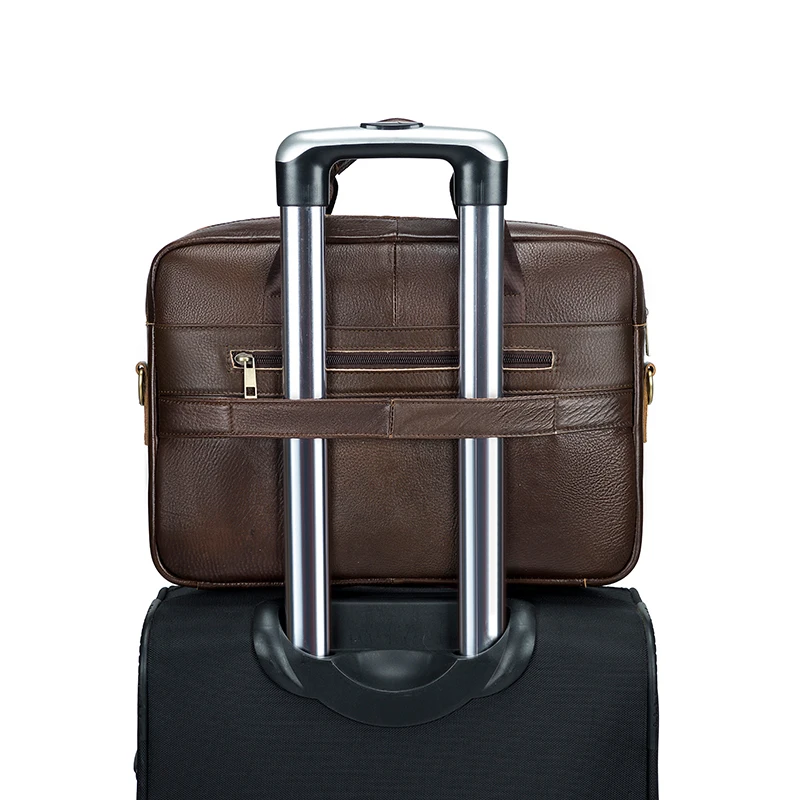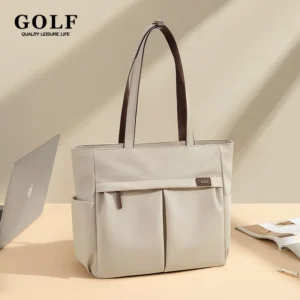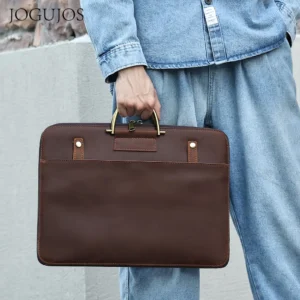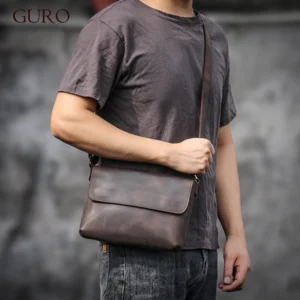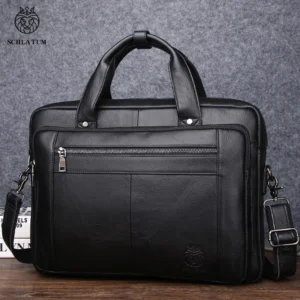Why Regular Maintenance of Your Office Leather Bag Matters
A quality leather office bag isn’t just an accessory—it’s an investment in your professional image and efficiency. Regular maintenance ensures your bag continues to make the right impression while providing practical service for years to come.
Proper leather care offers numerous benefits that extend beyond mere aesthetics:
- Preserves appearance: Regular cleaning prevents dirt buildup that can permanently discolor or damage leather
- Extends lifespan: Well-maintained leather can last decades rather than years
- Maintains structural integrity: Proper conditioning prevents cracking and weakening
- Protects your investment: Quality leather bags hold their value when properly maintained
- Enhances professional image: A pristine leather bag communicates attention to detail and professionalism
The difference between maintained and neglected leather becomes apparent surprisingly quickly. Neglected bags develop a dull, dry appearance within months, while maintained leather develops a rich patina that enhances its character over time. The approach to care varies significantly depending on the leather type—what works for full-grain may damage patent leather.
Understanding how to care for your specific timeless classic leather briefcase is essential to preserving its beauty and functionality throughout your professional career.
Understanding Your Leather: Identifying Different Types and Their Care Needs
Before attempting any cleaning or maintenance, you need to identify what type of leather your office bag is made from. Different leathers have distinct characteristics that demand specific care approaches.
| Leather Type | Appearance | Texture | Durability | Special Care Needs |
|---|---|---|---|---|
| Full-Grain | Natural markings visible | Firm, becomes softer with use | Highest | Regular conditioning, avoid excess water |
| Top-Grain | Smooth, uniform | Softer than full-grain | High | Gentle cleaning, regular conditioning |
| Saffiano | Cross-hatch pattern | Textured, scratch-resistant | Very high | Minimal conditioning, dust removal |
| Patent | Glossy, reflective | Smooth, plastic-like | Medium | Avoid oil-based products, use specialized cleaners |
| Genuine | Varying appearance | Often stiffer | Medium to low | Gentle conditioning, avoid harsh chemicals |
| Bonded | Uniform, may have artificial grain | Consistent, sometimes stiff | Low | Minimal water, special bonded leather conditioner |
| Suede/Nubuck | Fuzzy, velvety | Soft, raised nap | Medium | Specialized brushes, waterproofing sprays |
Identifying your leather type correctly ensures you won’t damage your bag with inappropriate products or techniques. For example, products designed for smooth leather can ruin suede, while waterproofing sprays meant for suede might leave residue on full-grain leather.
The inherent qualities of full-grain leather bags make them particularly rewarding to maintain, as they develop a unique patina over time that reflects their journey with you. Understanding these distinctions helps you make informed decisions about the care products and techniques appropriate for your specific office bag.
Essential Tools and Products for Leather Bag Maintenance
A well-stocked leather care kit allows you to address daily maintenance and occasional deep cleaning. Here are the essential items every leather bag owner should have:
- Microfiber cloths – Soft, lint-free cloths that won’t scratch leather surfaces; keep separate cloths for cleaning and conditioning
- Leather cleaner – pH-neutral formula specifically designed for leather (avoid household soaps that can strip natural oils)
- Leather conditioner – Replenishes moisture and prevents drying and cracking
- Soft-bristled brush – For removing dust and debris from crevices and seams
- Leather protection cream/spray – Creates a barrier against moisture and stains
- Suede brush and eraser – Special tools for suede or nubuck (if applicable)
- Cotton swabs – For precision cleaning around hardware and in tight corners
- Leather-safe stain remover – For addressing specific stains without damaging the leather
When selecting products, quality matters significantly. Low-quality conditioners may provide immediate shine but can damage leather over time. Look for products from established leather care brands and always test new products on an inconspicuous area first.
For specialty leathers, you’ll need additional tools. Saffiano leather requires less conditioning but benefits from a soft brush to clean its textured surface. Suede demands specialized brushes and erasers that won’t damage its delicate nap.
Investing in proper care tools is essential when maintaining classic leather briefcases and ensures your professional bag remains in optimal condition throughout its lifespan.
Daily Care Routine: Simple Habits to Extend Your Bag’s Life
Developing a few simple daily habits can dramatically extend your leather bag’s lifespan and keep it looking professional between deeper cleanings:
End-of-Day Quick Care (30 seconds)
* Gently empty all contents
* Wipe exterior with a clean, dry microfiber cloth
* Check for and address fresh stains immediately
* Allow the bag to air out (with compartments open if possible)
Preventative Measures
* Keep pens capped and sealed when not in use
* Store cosmetics and liquids in leak-proof containers
* Use a bag hook to keep your bag off potentially dirty floors
* Handle with clean, dry hands to prevent oil transfer
* Avoid placing your bag on rough surfaces that could scratch the leather
Workplace Hazard Prevention
* Keep your bag away from direct sunlight while at your desk
* Maintain distance from radiators and heating vents
* Use a desktop stand to keep your bag upright and properly shaped
* Apply a quarterly protection cream to create a barrier against coffee spills and ink marks
Professionals who implement these simple habits report significantly longer lifespans for their leather bags. A quality leather bag that receives proper daily care can maintain its professional appearance for decades rather than years.
Understanding how to properly maintain leather briefcases through these daily habits establishes the foundation for more thorough periodic maintenance.
Weekly Inspection: What to Check and Address
Dedicating just five minutes each week to inspect your leather bag can prevent minor issues from becoming major problems. Use this simple checklist during your weekly inspection:
- Exterior leather condition – Look for dry patches, scratches, or scuff marks that need attention
- Hardware integrity – Check that zippers, clasps, and buckles function smoothly
- Stress points – Examine handles, straps, and corners for signs of wear or cracking
- Interior condition – Check for spills, stains, or tears in the lining
- Unusual odors – Detect and address any developing smells before they set in
When inspecting, pay particular attention to the early warning signs of potential problems:
- White or gray patches indicating leather dryness
- Slight stiffening of previously supple leather
- Minor color transfer from clothing to leather
- Early signs of handle thread fraying
- Zipper teeth that occasionally catch
Address minor issues immediately using appropriate techniques. For example, apply conditioner to dry patches, or use a matching leather polish for small scuffs. This proactive approach prevents the need for more intensive restoration later.
Weekly inspection is particularly important for bags made with distinctive leather types like those found in full-grain messenger bags, as catching issues early preserves their unique character and texture.
Deep Cleaning Process: Step-by-Step Guide
While daily and weekly care prevents major issues, your leather office bag will periodically need a thorough deep cleaning. Most office bags benefit from deep cleaning every 3-6 months, depending on use frequency and exposure to elements.
Before You Begin:
1. Empty the bag completely and shake out loose debris
2. Test all cleaning products on an inconspicuous area first
3. Work in a well-ventilated area away from direct heat or sunlight
4. Have all your supplies ready before starting
Step-by-Step Deep Cleaning Process:
Dusting and Initial Preparation (5 minutes)
* Use a soft brush to remove surface dust and debris
* Pay special attention to seams and crevices
* Gently vacuum the interior using a soft brush attachmentCleaning the Exterior (10-15 minutes)
* Dampen (not wet) a microfiber cloth with leather cleaner
* Work in small sections using gentle circular motions
* Avoid oversaturating the leather
* Pay extra attention to handles and areas that contact skinAddressing the Interior (10 minutes)
* Use appropriate cleaner based on lining material
* For fabric linings, use a fabric cleaner on a damp cloth
* For leather linings, use the same cleaner as the exterior but with a lighter touch
* Allow interior to dry completely with compartments openDrying Process (8-24 hours)
* Gently blot excess moisture with a dry cloth
* Shape the bag using acid-free tissue paper or a clean towel
* Allow to air dry naturally away from heat sources
* Never use hairdryers or heaters to speed dryingFinal Inspection (5 minutes)
* Check that all areas are clean and completely dry
* Identify any spots that may need targeted treatment
For bags with stubborn stains or specific issues, you might need more specialized cleaning techniques for leather bag stains before proceeding to the conditioning step.
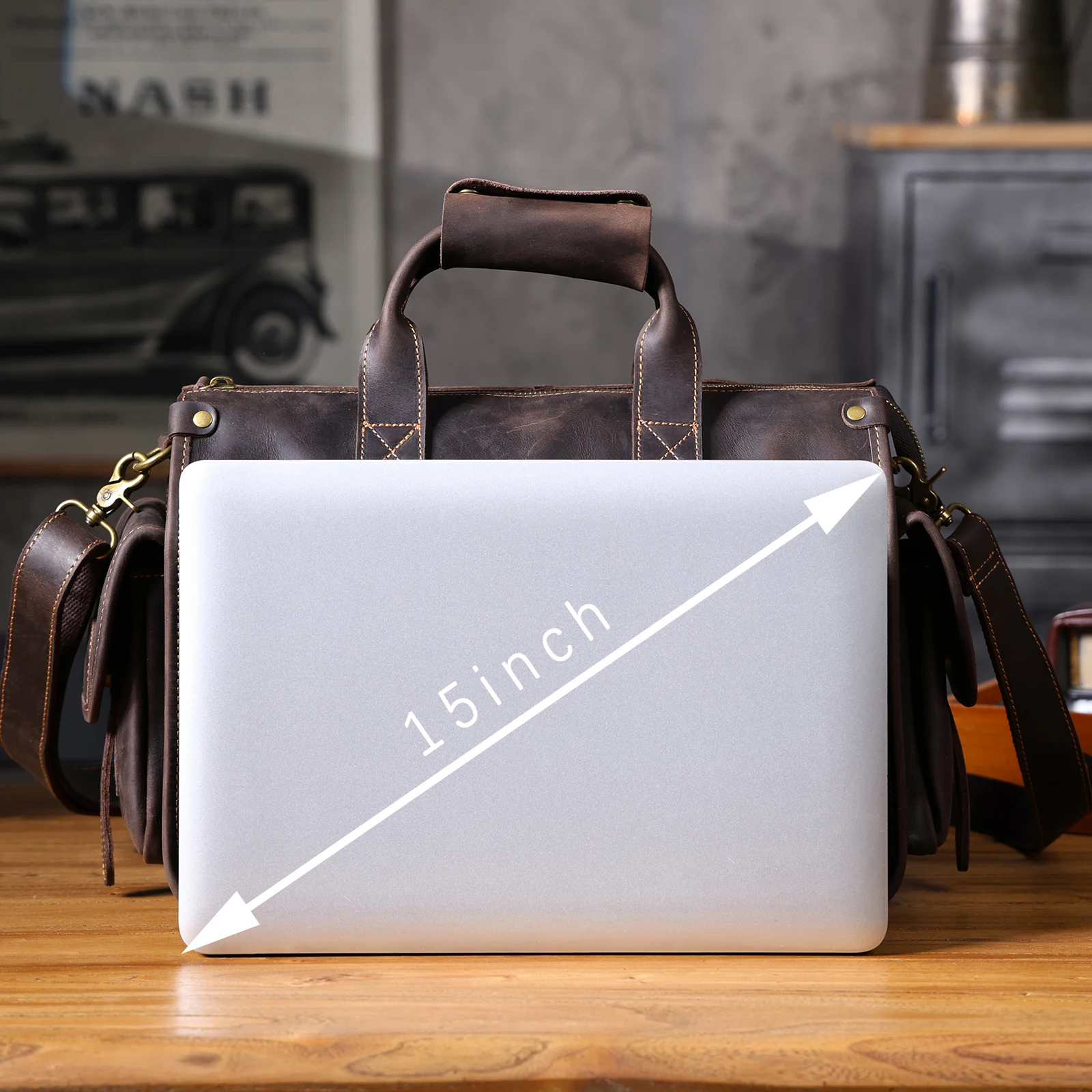
Leather Conditioning: Nourishing Your Bag for Longevity
After cleaning, conditioning is essential to restore moisture and maintain the leather’s supple nature. Think of conditioning as providing nourishment that keeps leather healthy, just as moisturizer benefits skin.
When to Condition:
* After each deep cleaning
* When leather feels dry or stiff to the touch
* Before and after seasonal storage
* Typically every 3-6 months for regularly used bags
* More frequently in dry climates or air-conditioned offices
Conditioning Process:
1. Select a conditioner appropriate for your specific leather type
2. Apply a small amount to a clean microfiber cloth (not directly onto the leather)
3. Work the conditioner into the leather using small circular motions
4. Apply thin, even coats rather than one thick layer
5. Pay special attention to stress points like handles and corners
6. Allow the conditioner to absorb for the time specified on the product (typically 10-30 minutes)
7. Gently buff away any excess with a clean cloth
8. Allow 24 hours for the conditioner to fully penetrate before using the bag
Visual Cues for Proper Conditioning:
* Leather should appear subtly rejuvenated, not greasy
* The surface should feel soft and supple when touched
* Color should be even and rich, not blotchy or dull
Seasonal adjustments are important for optimal conditioning. Winter’s dry indoor heating requires more frequent conditioning, while humid summers may require less. This maintenance step is crucial for all professional leather bags, including mens professional leather messenger styles that see daily use.
Addressing Common Stains and Damage: Targeted Solutions
Even with regular care, office leather bags inevitably encounter stains and damage. The key to successful treatment is prompt action with the right technique for each specific issue.
Ink Stains:
* Blot immediately without rubbing (which spreads the stain)
* Apply leather-specific ink remover with a cotton swab
* For ballpoint ink, try rubbing alcohol on a cotton swab (test in an inconspicuous area first)
* Work from the outside of the stain inward
* Be patient—aggressive scrubbing damages leather
Water Spots:
* Allow to air dry naturally (never use direct heat)
* For minor spots, gentle buffing with a microfiber cloth may suffice
* For stubborn water rings, apply a tiny amount of distilled water to the entire panel to even out drying
* After drying, apply conditioner to the affected area
Oil and Grease:
* Blot excess oil immediately without rubbing
* Sprinkle cornstarch or talcum powder to absorb the oil
* Let sit for several hours or overnight
* Brush away powder gently
* Repeat if necessary before cleaning with leather cleaner
Surface Scratches:
* For minor scratches, try gently rubbing with a slightly damp finger
* Apply a small amount of conditioner to the scratch
* For deeper scratches, use a matching leather cream
* Very deep scratches may require professional attention
Food Stains:
* Remove solid particles without spreading the stain
* Use a damp cloth with a tiny amount of mild soap
* Follow with a clean, damp cloth to remove soap residue
* Condition after the area is completely dry
Implementing these targeted solutions can address most common office hazards. For more extensive guidance on maintaining your bag’s appearance, explore techniques for preventing scratches on leather briefcases.
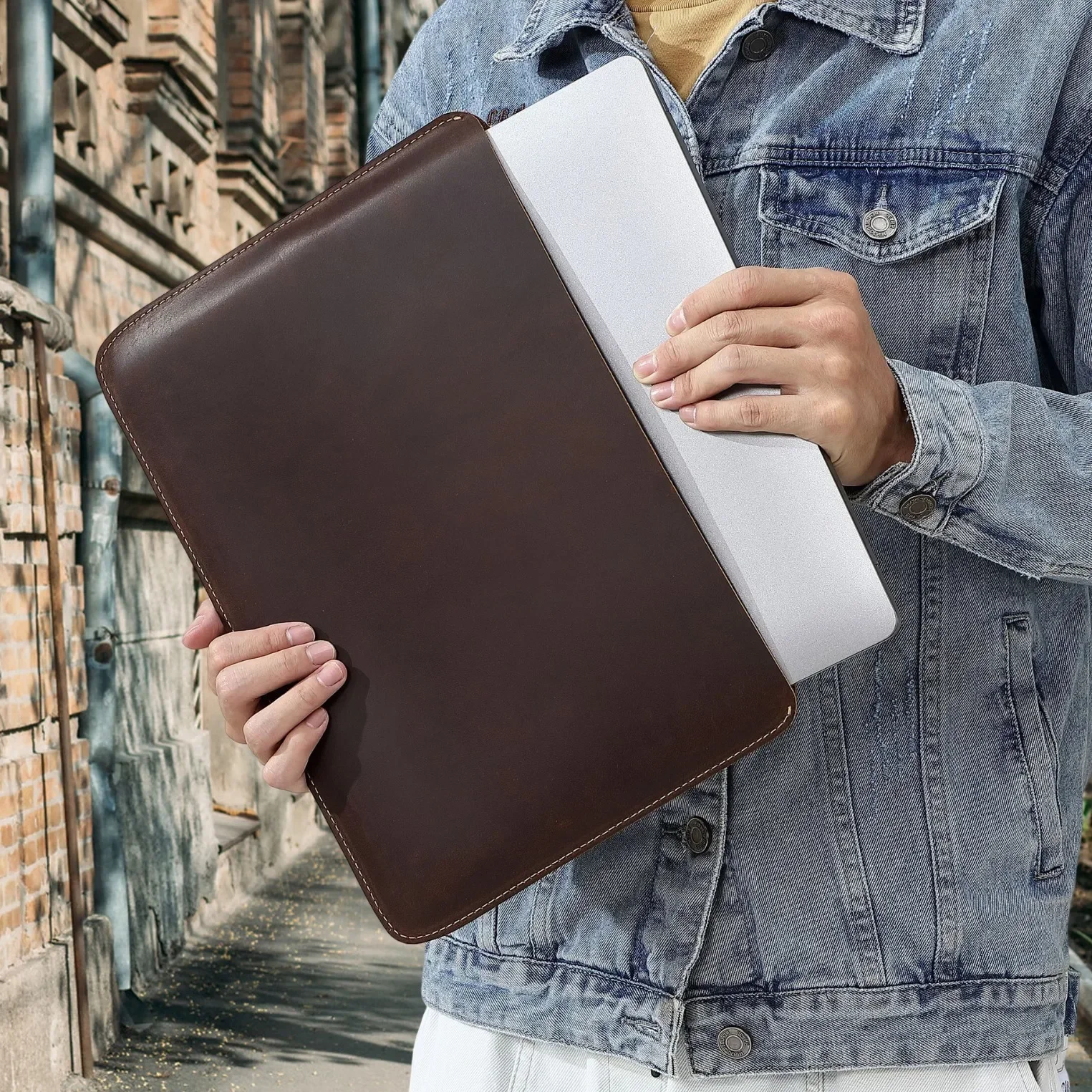
Specialized Care for Different Leather Finishes
Each leather finish has unique characteristics requiring specialized care approaches. Understanding your bag’s specific finish ensures you’ll use appropriate techniques.
Full-Grain and Top-Grain Leather:
* Use pH-balanced cleaners that won’t strip natural oils
* Condition regularly to maintain suppleness
* Embrace the developing patina as a sign of character
* Apply leather cream rather than liquid conditioners
Saffiano and Textured Leather:
* Use a soft brush to clean between the textured pattern
* Apply less conditioner than you would for smooth leather
* Concentrate on keeping the pattern clean and defined
* Use protection sprays formulated for textured leathers
Patent Leather:
* Avoid oil-based products completely
* Clean with a damp cloth and specialized patent leather cleaner
* Use vinyl or patent-specific products for shine
* Store with tissue paper between patent surfaces to prevent sticking
Suede and Nubuck:
* Never use liquid cleaners or water
* Use only brushes specifically designed for suede
* Apply suede-specific protector sprays
* Address stains with a suede eraser rather than liquid removers
Vegetable-Tanned Leather:
* Embrace natural darkening that occurs with age and exposure
* Use minimal water during cleaning
* Apply conditioners specifically formulated for veg-tanned leather
* Buff vigorously to bring out natural luster
Understanding these distinctions is particularly important when maintaining specialty items like crazy horse leather satchels, which develop a unique patina based on how they’re maintained.
Hardware and Lining Care: Beyond the Leather
While leather commands the most attention, hardware and lining require specific care to maintain overall bag functionality and appearance.
Metal Hardware Maintenance:
* Brass and Gold-Tone: Clean with a soft cloth and brass cleaner; apply a thin coat of Renaissance wax for protection
* Silver and Chrome: Use a jewelry polishing cloth; avoid harsh chemicals
* Matte Hardware: Clean with a soft, dry cloth only; avoid polishes that create shine
Hardware Issues and Solutions:
* Sticky Zippers: Apply a minimal amount of zipper lubricant or rub with a pencil lead
* Tarnished Metal: Use a metal-specific polish and soft cloth
* Loose Screws: Tighten carefully with an appropriately sized screwdriver
* Squeaky Hinges: Apply a tiny amount of sewing machine oil
Lining Care Based on Material:
* Fabric Lining: Vacuum with soft brush attachment; spot clean with fabric cleaner
* Leather Lining: Wipe with slightly damp cloth; allow to dry completely
* Synthetic Lining: Clean with mild soap solution; dry thoroughly to prevent mildew
Preventative Care:
* Keep interior organized to minimize strain on lining
* Use pouches for potentially leaky items
* Remove dust and debris weekly to prevent abrasion damage
* Address spills immediately before they set into lining fabric
Proper hardware maintenance ensures your leather laptop work tote remains fully functional while maintaining its professional appearance.
Proper Storage: Protecting Your Investment When Not in Use
How you store your leather bag when not in use significantly impacts its longevity and appearance when you return to using it.
Preparation Before Storage:
* Clean and condition thoroughly
* Empty all contents completely
* Check pockets for forgotten items
* Stuff with acid-free tissue paper or clean cotton fabric to maintain shape
* Ensure the bag is completely dry before storing
Ideal Storage Conditions:
* Cool, dry environment (40-60% humidity)
* Away from direct sunlight
* Good air circulation
* No contact with plastic bags or containers
* Protected from dust with breathable cotton covers
Shape Maintenance During Storage:
* Stuff interior compartments to prevent collapsing
* Support handles in natural position to prevent creasing
* Place heavier items on bottom and lighter items on top if storing multiple bags
* Rotate bags periodically if stored for extended periods
Duration Guidelines:
* Short-term (1-4 weeks): Minimal preparation needed
* Medium-term (1-6 months): Full cleaning, conditioning, and proper stuffing
* Long-term (6+ months): All above plus quarterly checks and air-outs
Storage Don’ts:
* Never store in plastic bags (traps moisture)
* Avoid hanging by handles (causes stretching)
* Don’t stack heavy items on top of bags
* Avoid storage near heating vents or humid areas
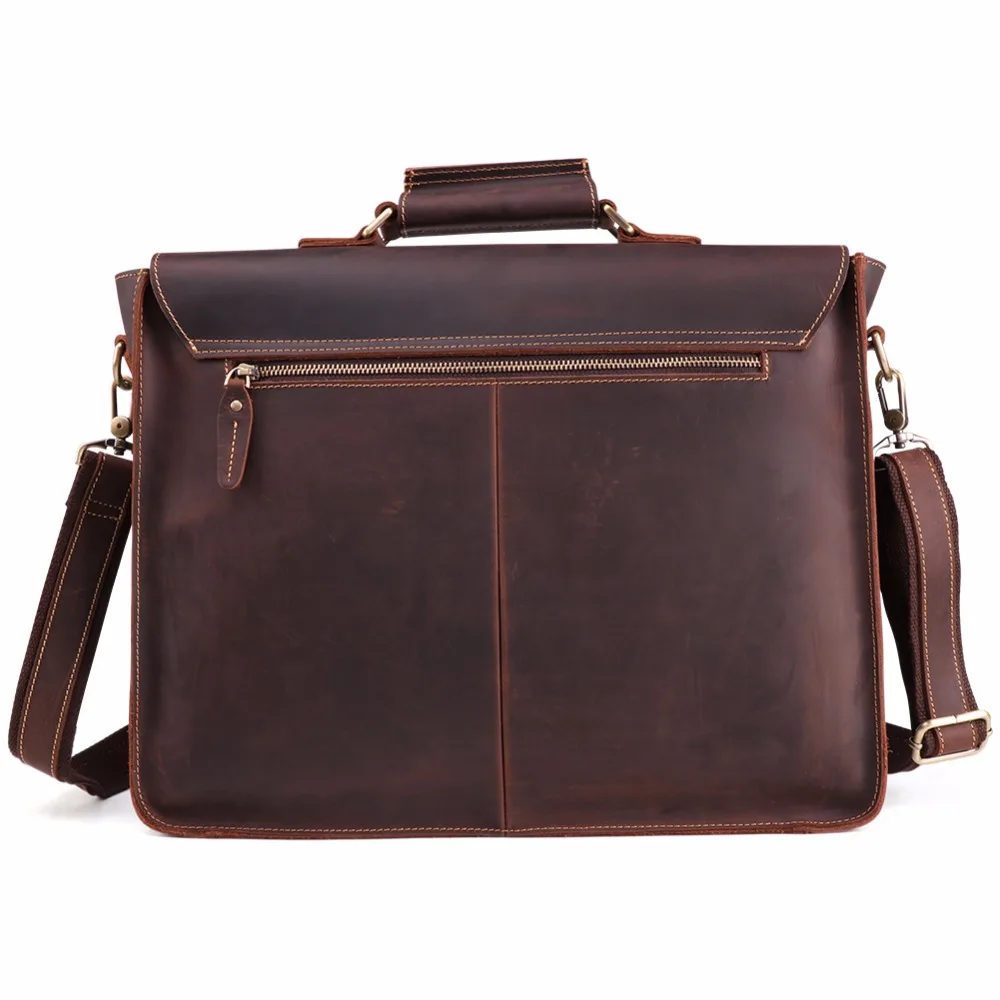
Men's Classic Leather Briefcase, Slim Leather Laptop Briefcase, Slim Leather Portfolio Briefcase
$93.67 Select options This product has multiple variants. The options may be chosen on the product pageLeather Laptop Work Tote, Tan Leather Work Tote, Women's Leather Work Tote, Zippered Leather Work Tote
Price range: $223.62 through $237.97 Select options This product has multiple variants. The options may be chosen on the product pageClassic Laptop Briefcase, Men's Classic Leather Briefcase, Slim Leather Attache Case
Price range: $353.50 through $360.81 Select options This product has multiple variants. The options may be chosen on the product pageBlack Leather Briefcase, Leather Document Bag, Men's Classic Leather Briefcase
Genuine Crocodile Leather Executive Briefcase with Password Lock – Premium Business Document Carrier$1,201.87 Select options This product has multiple variants. The options may be chosen on the product pageCrazy Horse Leather Satchel, Men's Leather Satchel, Men's Professional Leather Messenger, Vintage Style Messenger Bag
$132.70 Select options This product has multiple variants. The options may be chosen on the product pageBlack Leather Briefcase, Classic Laptop Briefcase, Men's Classic Leather Briefcase, Slim Leather Laptop Briefcase
$228.72 Select options This product has multiple variants. The options may be chosen on the product page
Critical Do’s and Don’ts: Expert Guidelines
After years of manufacturing premium leather goods, Poise Porter has compiled these essential guidelines to help you maximize your bag’s lifespan.
Do’s:
* Test all new products on an inconspicuous area first
* Clean spills immediately before they set
* Use products specifically designed for your leather type
* Store in a cool, dry place away from direct sunlight
* Condition regularly based on usage and environment
* Allow wet bags to dry naturally and completely
* Keep leather away from oil, alcohol, and perfume
* Apply leather protector before first use and seasonally
* Rotate between bags to allow each to rest and recover
Don’ts:
* Use household cleaners or soaps on leather
* Apply direct heat to dry wet leather
* Oversaturate with conditioner or cleaner
* Store in plastic bags or airtight containers
* Leave in direct sunlight or hot environments
* Use silicone-based products that trap moisture
* Apply oils or conditioners to suede or nubuck
* Ignore small issues until they become major problems
* Overstuff your bag beyond its designed capacity
* Use alcohol-based products on finished leather
These guidelines apply to all quality leather items, including professional leather briefcases that represent a significant investment in your professional image.
When to Seek Professional Help: Recognizing Your Limits
While most leather maintenance can be handled at home, certain situations warrant professional intervention:
Signs Professional Help Is Needed:
* Deep cuts or tears in the leather
* Significant color loss or fading
* Hardware that requires replacement
* Structural damage to handles or straps
* Severe water or liquid damage
* Mold or mildew development
* Strong odors that home remedies don’t address
* Stitching that has come undone
* Color transfer that won’t come out with standard cleaning
Finding Qualified Leather Professionals:
* Seek specialists with experience in your specific leather type
* Request examples of previous restoration work
* Ask about their process and products used
* Confirm pricing structure before proceeding
Cost-Benefit Considerations:
* Minor professional repairs typically cost $50-100
* Major restorations can reach $200+ depending on damage
* Compare repair costs against replacement value
* Consider sentimental value alongside monetary considerations
Even bags made from vegan leather alternatives sometimes require professional care for significant damage, though the techniques and specialists may differ.
Seasonal Care Adjustments: Adapting to Environmental Changes
Leather responds dramatically to environmental conditions, making seasonal care adjustments essential for maintaining your bag’s condition throughout the year.
Winter Care:
* Increase conditioning frequency to combat dry indoor heating
* Apply weatherproofing spray before exposure to snow or slush
* Wipe salt marks immediately with a damp cloth
* Allow bag to dry completely when brought in from cold
* Store away from direct heat sources that cause leather to dry out
Summer Care:
* Protect from increased UV exposure with leather sunscreen
* Clean more frequently due to increased perspiration transfer
* Watch for mildew in humid conditions
* Avoid leaving in hot cars where leather can dry and crack
* Apply lighter conditioning treatments more frequently
Spring/Fall Transitions:
* Deep clean between seasons
* Check for issues developed during previous season
* Adjust conditioning schedule for changing humidity levels
* Apply appropriate protectants for upcoming seasonal challenges
Climate-Specific Considerations:
* Humid Environments: Focus on mold prevention and more frequent cleaning
* Dry Climates: Emphasize regular conditioning and moisture restoration
* Variable Climates: Create a flexible care schedule based on current conditions
These seasonal adjustments should be considered when choosing the perfect leather briefcase for your specific climate and working environment.
Supplemental Content: Eco-Friendly and Natural Leather Care Alternatives
For those seeking more sustainable approaches to leather care, several natural alternatives can effectively clean and condition your office bag:
Natural Leather Cleaner Recipe:
* 2 parts white vinegar
* 1 part water
* Few drops of essential oil (optional, for scent)
* Mix in a spray bottle, apply sparingly with a microfiber cloth
DIY Leather Conditioner:
* 1 part white vinegar
* 2 parts linseed oil or olive oil
* Mix thoroughly and apply a small amount with soft cloth
* Allow to sit for 12 hours, then buff thoroughly
Natural Stain Removers:
* Lemon juice and cream of tartar paste for light-colored leathers
* Diluted vinegar for water spots
* Baking soda paste for oil stains (allow to absorb, then brush away)
Environmental Benefits:
* Reduced chemical exposure for both leather and user
* Lower environmental impact from manufacturing and packaging
* Minimized volatile organic compounds (VOCs) in your home and office
While natural alternatives are generally effective for routine maintenance, they may not provide the same level of protection or restoration as specialized products for significant damage or highly finished leathers.
Supplemental Content: Caring for Vegan Leather Alternatives in Office Bags
Vegan leather alternatives require different care approaches than genuine leather, though they still benefit from regular maintenance:
General Vegan Leather Care:
* Clean with mild soap and water rather than leather products
* Avoid alcohol-based cleaners which can dry out synthetic materials
* Apply silicone or water-based protectants designed for synthetics
* Keep away from extreme temperatures that can cause warping or cracking
PU (Polyurethane) Leather Care:
* Clean with a soft cloth and mild soap solution
* Dry immediately and thoroughly
* Use vinyl conditioner specifically formulated for synthetics
* Protect from UV exposure which degrades PU faster than genuine leather
Cork and Plant-Based Leather Alternatives:
* Clean with damp cloth only
* Apply specialized plant-based waxes for protection
* Keep away from excess moisture which can cause warping
* Store in breathable bags rather than plastic
Durability Expectations:
* With proper care, quality vegan alternatives typically last 3-5 years
* Watch for surface peeling, which indicates end of useful life
* Address edge wear early as it progresses more rapidly than with genuine leather
By understanding the specific needs of different materials, you can maintain both traditional leather and modern alternatives in optimal condition throughout their useful life.

